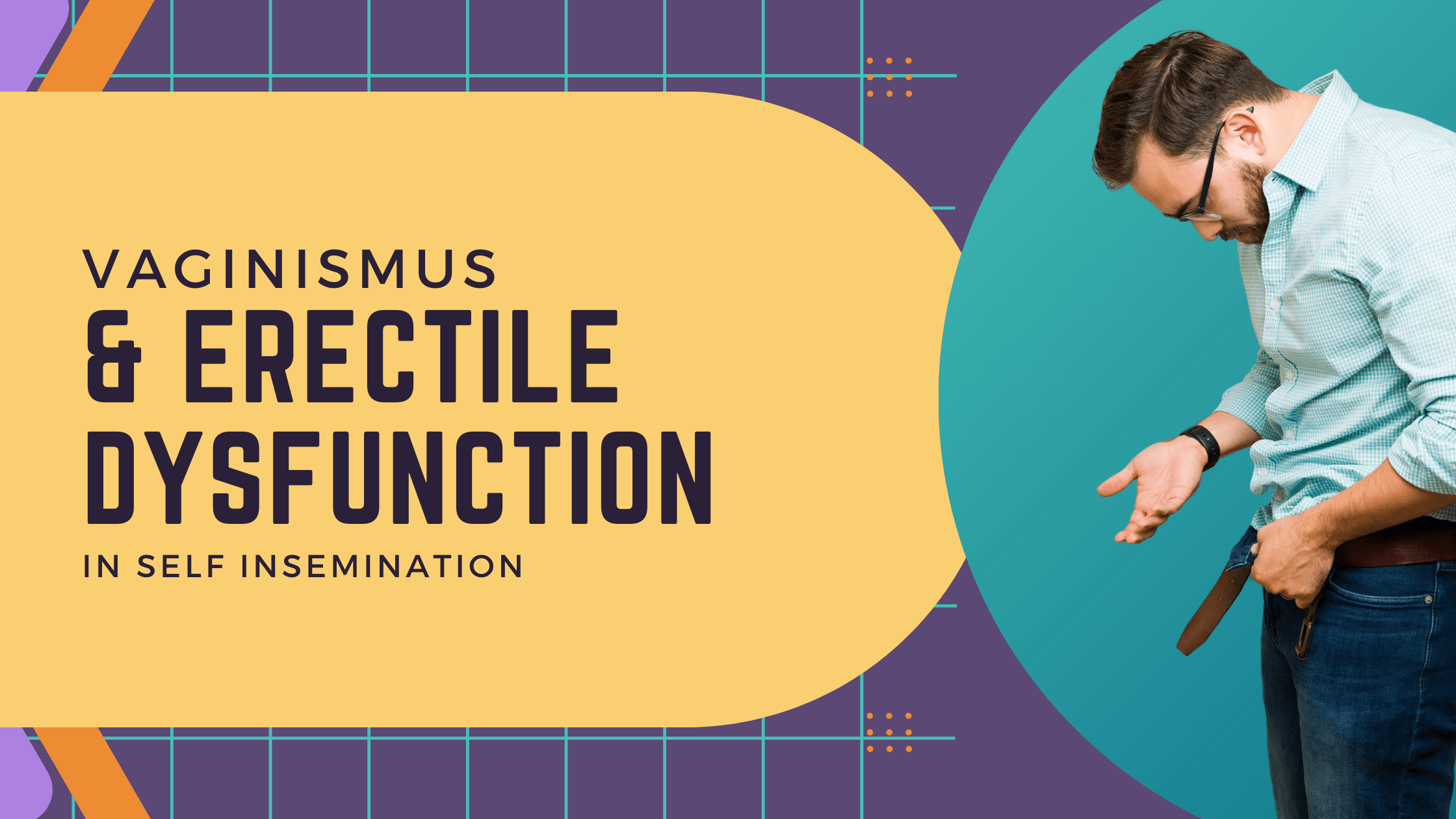When it comes to starting a family, there can be a lot of challenges that couples may face. Two such issues are Vaginismus and Erectile Dysfunction, which can make conception difficult.
However, with the right knowledge and resources, these challenges can be overcome. In this blog post, we will explore both Vaginismus and Erectile Dysfunction in detail, including their causes and impact on conception.
We will also discuss self-insemination as an effective solution for overcoming sexual dysfunctions and achieving pregnancy. We will outline the steps involved in self-insemination and provide tips for success.
Additionally, we will cover non-surgical treatment options, counseling services, and lifestyle changes that can help treat these conditions. With our expert guidance and support system recommendations, you’ll have all the tools you need to navigate the path to parenthood with confidence!
Understanding Vaginismus
Vaginismus is a condition that affects the vaginal muscles, causing them to involuntarily contract, which makes sexual intercourse and other activities involving penetration painful or impossible.
It can have significant implications for a person’s sexual health, quality of life, and overall well-being. Vaginismus is a form of sexual dysfunction, but the physical and psychological aspects of this condition often intertwine, contributing to its complexity and treatment challenges.
The physical and psychological aspects of Vaginismus
Vaginismus is a condition that involves both physical and psychological factors, and understanding the relationship between the two is crucial for effective treatment.
The physical manifestations of vaginismus can significantly impact sexual health and relationships. When the vaginal muscles contract involuntarily, sexual intercourse and other activities involving vaginal penetration can become painful or impossible. This can lead to sexual dysfunction and a decline in sexual desire and pleasure, affecting an individual’s quality of life.
Psychological factors play a significant role in the development and persistence of vaginismus.
Anxiety, fear of pain, trauma, and negative sexual experiences can contribute to the psychological barriers experienced by individuals with vaginismus. The fear of pain and the anticipation of unsuccessful attempts at intercourse can result in muscle tension and further exacerbate the condition.
Treating vaginismus involves addressing both the physical and emotional aspects of the condition. Physical therapy, such as pelvic floor exercises and vaginal dilators, can help relax the muscles and retrain the body’s response to penetration.
Behavioral therapy, including relaxation techniques and progressive desensitization, can assist individuals in overcoming psychological barriers and improving sexual function.
Prevalence and Incidence
Understanding the prevalence and incidence of vaginismus is essential for creating awareness and developing appropriate interventions. Vaginismus can affect individuals regardless of age or background, and its impact on sexual intercourse and overall sexual health can be far-reaching.
The prevalence of vaginismus varies across different populations, with estimates ranging from 0.5% to 6% of women experiencing some degree of vaginismus at some point in their lives.
This wide range reflects the challenges of determining the true prevalence of vaginismus due to underreporting and limited research in certain communities.
When it comes to incidence, vaginismus can arise at any point in a person’s life, from the onset of sexual activity to later stages in life.
It can occur in individuals with no history of sexual problems, as well as those who have experienced trauma or negative sexual experiences. Vaginismus can significantly impact sexual relationships, leading to frustration, anxiety, and diminished quality of life if not addressed.
Increasing awareness of the prevalence and incidence of vaginismus is crucial in eradicating the stigma surrounding sexual problems and encouraging individuals to seek help and support.
Public health initiatives and education can play a vital role in improving access to care and reducing the burden of vaginismus on affected individuals.
Exploring Erectile Dysfunction
While vaginismus primarily affects women, erectile dysfunction predominantly affects men and can also have a profound impact on sexual health and conception.
Erectile dysfunction refers to the inability to achieve or maintain an erection firm enough for sexual intercourse. It is a prevalent condition with various physical and psychological causes that compromise sexual function and overall sexual health.
Root causes of Erectile Dysfunction
Understanding the root causes of erectile dysfunction is essential for targeted treatment and optimal sexual function and health.
Erectile dysfunction can stem from a combination of physiological and psychological factors.
Physiological causes may include medical conditions such as diabetes, cardiovascular disease, hormonal imbalances, and side effects of certain medications. Psychological issues, such as stress, anxiety, depression, and relationship problems, can also contribute to erectile dysfunction.
Addressing the diverse causes of erectile dysfunction requires a comprehensive approach. Medical interventions, including medications and treatments for underlying health conditions, may be necessary to restore erectile function in some cases.
Counseling and therapy can be beneficial in managing psychological issues and addressing relationship dynamics, enhancing sexual desire and function.
The impact of erectile dysfunction on conception should also be considered for couples trying to start a family. Erectile dysfunction can create challenges and psychological stress, as it can affect sexual performance and hinder natural conception. Seeking professional guidance and exploring alternative methods, such as self-insemination, may be necessary for couples facing fertility issues related to erectile dysfunction.
Impact of Erectile Dysfunction on conception
Erectile dysfunction can have a significant impact on couples’ attempts to conceive naturally and their overall quality of life. The challenges of erectile dysfunction in conception necessitate careful consideration and potential intervention.
Couples facing erectile dysfunction may experience frustration, anxiety, and strained sexual relationships.
The inability to achieve or maintain an erection can lead to reduced sexual desire and pleasure, undermining the sexual intimacy necessary for successful conception.
Additionally, the psychological impact of erectile dysfunction, such as feelings of inadequacy and shame, can further hinder the conception process.
Addressing the impact of erectile dysfunction on conception often requires medical intervention and support.
Consulting healthcare providers, fertility specialists, and sex therapists can help couples navigate the path to parenthood and explore alternative methods of conception, such as self-insemination.
Open communication, understanding, and perseverance are key in managing the challenges related to erectile dysfunction and maintaining a healthy sexual relationship.
The Intersection of Vaginismus and Erectile Dysfunction
Vaginismus and erectile dysfunction are two conditions that can coexist and create additional challenges for couples striving for a satisfying sexual relationship and conception.
Understanding the intersection of these conditions is crucial for addressing the unique difficulties faced by couples dealing with both vaginismus and erectile dysfunction.
Challenges Faced By Couples
Couples overcoming vaginismus and erectile dysfunction face a range of challenges. Dealing with sexual disorders and navigating treatment processes can put a strain on intimacy and psychological well-being.
Couples therapy and relationship counseling can offer valuable support in addressing these challenges and fostering a positive and understanding environment.
Couples coping with vaginismus and erectile dysfunction often require specialized therapeutic approaches that holistically encompass their unique needs and circumstances.
Treating sexual trauma, managing psychological issues, and exploring alternative methods of sexual pleasure can contribute to enhancing sexual well-being and relationship satisfaction.
Socio-cultural implications and misconceptions
Socio-cultural implications and misconceptions surrounding vaginismus and erectile dysfunction can further burden couples seeking treatment and support.
Unresolved cultural biases and societal taboos may hinder individuals experiencing sexual problems from seeking help and openly discussing their conditions.
In some Eastern countries, for example, vaginismus and erectile dysfunction are often met with silence and shame, leading to misconceptions and misconstrued beliefs about sexual health.
Couples grappling with these conditions may face additional challenges, such as unconsummated marriages, psychological distress, and strained family relationships.
Combatting these socio-cultural implications requires education, awareness, and advocacy.
Open dialogue, destigmatization of sexual dysfunctions, and providing accurate information about treatment options can aid in breaking down barriers and empowering couples affected by vaginismus and erectile dysfunction to seek the help they need.
Breaking Down Self Insemination
Self-insemination offers an alternative approach for couples experiencing vaginismus and erectile dysfunction, allowing them to pursue their desire for parenthood.
Understanding the process of self-insemination and its role in overcoming sexual dysfunctions is key to empowering individuals and couples with this option.
The process of Self Insemination
Self-insemination involves the insertion of sperm into the vagina without sexual intercourse, and it can be an effective method for couples dealing with sexual dysfunctions, such as vaginismus and erectile dysfunction.
By bypassing the physical challenges associated with sexual intercourse, self-insemination provides an alternative path to conception and overcomes the limitations imposed by these conditions.
Timing and technique are crucial in self-insemination. Couples must track ovulation and prepare the sperm for successful insemination.
By understanding the female reproductive system and implementing the appropriate techniques, couples can optimize their chances of conception through self-insemination.
In addition to addressing fertility challenges, self-insemination plays a role in overcoming sexual dysfunctions and enhancing sexual pleasure and intimacy.
It allows couples to experience the joy of parenthood while navigating the complexities of their sexual health conditions.
The role of self-insemination in overcoming sexual dysfunctions
Self-insemination can be a meaningful solution for couples dealing with vaginismus and erectile dysfunction.
By removing the physical and psychological barriers of sexual intercourse, self-insemination offers a comfortable and empowering option for conception.
For individuals with vaginismus, self-insemination eliminates the fear of pain and muscle tension that can hinder sexual intercourse. It allows them to engage in pleasurable sexual activities while working towards starting a family.
Similarly, for individuals with erectile dysfunction, self-insemination provides an opportunity for conception without the pressure and performance anxiety associated with sexual intercourse.
Embracing self-insemination as a means of overcoming sexual dysfunctions requires a supportive and informed approach.
Couples should seek professional guidance, build a strong support system, and explore the emotional and physical aspects of the process.
By empowering themselves with this alternative method, couples can embark on a journey of love, intimacy, and parenthood.
Effective Strategies for Self Insemination
The successful execution of self-insemination involves careful preparation and the utilization of effective strategies. Let us explore the key steps and techniques in self-insemination, empowering couples to approach this journey with confidence and assurance.
Preparing for the journey
Preparing for the self-insemination journey involves addressing and managing the underlying conditions of vaginismus and erectile dysfunction.
Couples may benefit from seeking treatment for vaginismus and erectile dysfunction before attempting self-insemination, enhancing sexual desire and optimizing sexual health.
Addressing vaginismus through treatment, such as pelvic floor exercises and dilator therapy, can help relax the vaginal muscles and improve sexual function.
Similarly, managing erectile dysfunction through therapy, medication, or lifestyle changes can contribute to successful self-insemination.
It is crucial for couples to establish a supportive and nurturing environment conducive to self-insemination.
This includes cultivating open communication, emotional support, and understanding of each other’s needs and boundaries.
Engaging in shared activities that promote relaxation and intimacy can also contribute to a positive mindset and increase the chances of successful self-insemination.
Key steps and techniques in self-insemination
To optimize the effectiveness of self-insemination, it is essential to follow key steps and techniques. These include:
- Tracking ovulation and understanding the female reproductive system.
- Preparing the sperm for insemination, ensuring its viability and quality.
- Utilizing relaxation techniques, such as deep breathing and progressive muscle relaxation, to promote a calm and comfortable environment.
- Gradually using vaginal dilators of increasing sizes to prepare the vaginal muscles for penetration.
- Practicing progressive desensitization techniques to reduce anxiety and fear of pain during the self-insemination process.
- By incorporating these strategies, couples can approach self-insemination with confidence and increase their chances of successful conception. It is essential to remain patient, persistent, and supportive of each other throughout this journey.
Treating Vaginismus and Erectile Dysfunction
Effective treatment options are available for vaginismus and erectile dysfunction, addressing the physical and psychological aspects of these conditions. Let us explore the non-surgical treatments, therapy and counseling, and lifestyle changes that can contribute to overcoming these challenges and improving sexual health.
Non-Surgical Treatment options
Non-surgical treatments play a significant role in addressing vaginismus and erectile dysfunction, offering effective options for individuals and couples experiencing these conditions.
Treatment sessions, both individual and couple therapy, can provide a safe and supportive space to address sexual health concerns and develop coping mechanisms.
Pelvic physiotherapy, which involves exercises to strengthen and relax the pelvic floor muscles, is highly beneficial in managing vaginismus.
Dilator therapy, utilizing vaginal dilators of different sizes, can help desensitize the vaginal muscles and gradually improve sexual function.
Behavioral therapy, such as cognitive-behavioral therapy, can aid in identifying and modifying negative thought patterns and behaviors associated with sexual dysfunction.
Couples therapy and relationship counseling can address psychological barriers, improve communication, and enhance sexual intimacy for couples facing vaginismus and erectile dysfunction.
Role of therapy and counseling
Therapy and counseling play a vital role in the treatment of vaginismus and erectile dysfunction, offering comprehensive support and guidance for individuals and couples.
Sex therapy, relationship therapy, and behavioral therapy are therapeutic approaches commonly utilized in addressing these conditions.
Sex therapy focuses on understanding and managing psychological and emotional aspects of sexual problems. It provides individuals and couples with techniques and tools to enhance sexual desire, function, and pleasure.
Relationship therapy and counseling help address issues arising from vaginismus and erectile dysfunction, such as strained relationships, lack of intimacy, and communication difficulties.
Behavioral therapy assists individuals in identifying and modifying behavioral patterns that contribute to sexual dysfunction, promoting healthier sexual experiences and interactions.
Addressing psychological problems, such as trauma, anxiety, and depression, through therapy and counseling, is essential for overcoming vaginismus and erectile dysfunction and achieving overall sexual well-being.
Lifestyle changes and their impact
Lifestyle changes can have a significant impact on managing vaginismus and erectile dysfunction and improving sexual health and quality of life.
Adopting a healthy lifestyle that incorporates regular exercise, balanced nutrition, and stress management can positively influence the management of these conditions and enhance sexual function.
For individuals with vaginismus, practicing relaxation techniques and incorporating pelvic floor exercises into daily routines can contribute to muscle relaxation and improved sexual function.
Dietary changes, such as reducing caffeine and alcohol intake, may also provide benefits.
For individuals with erectile dysfunction, lifestyle modifications, including regular exercise, a heart-healthy diet, and weight management, can help mitigate the impact of underlying health conditions contributing to erectile dysfunction.
Reducing stress levels and addressing relationship issues can also support healthier sexual function and desire.
It is important to approach lifestyle changes as part of a comprehensive treatment plan, working in conjunction with medical interventions and therapy.
Consulting healthcare providers and specialists is advised to develop personalized strategies that align with individual needs and health conditions.
Support Systems and Resources
Support systems and resources are invaluable for individuals and couples navigating vaginismus and erectile dysfunction. Let us explore the importance of partner and family support, as well as finding professional help and utilizing available resources.
Importance of partner and family support
Partner and family support is crucial in the journey of individuals grappling with vaginismus and erectile dysfunction. Emotional backing and understanding from partners and family members can significantly impact the treatment process and overall well-being.
Creating a supportive environment within the relationship involves open and honest communication, empathy, and patience.
Partners can engage in therapeutic activities and exercises, attend counseling sessions together, and participate actively in treatment plans, promoting a sense of togetherness and shared responsibility.
Family support, especially from close relatives, can provide added emotional and practical assistance.
Encouragement, reassurance, and active listening from family members alleviate feelings of isolation and distress, fostering a nurturing and safe space to address sexual health concerns.
Approaching treatment and overcoming vaginismus and erectile dysfunction as a collaborative effort strengthens sexual relationships and deepens emotional bonds.
The therapeutic approach is enriched through partner and family involvement, working towards a common goal of improved sexual health, pleasure, and overall well-being.
Finding professional help and resources
Finding professional help and utilizing available resources are essential for individuals and couples seeking to address vaginismus and erectile dysfunction effectively.
Consulting healthcare providers and specialists experienced in sexual health issues can provide expert guidance and tailored treatment plans.
Healthcare providers, such as gynecologists and urologists, possess the medical expertise to diagnose and treat vaginismus and erectile dysfunction, as well as provide referrals to appropriate specialists.
They can offer insights into available clinical trials and research studies, allowing individuals and couples to explore potential treatment advancements and emerging therapies.
Sex therapists, specializing in sexual health and relationship dynamics, can provide therapeutic sessions and counseling, offering valuable support and guidance throughout the treatment journey.
They can assess and address psychological issues, trauma, and relationship challenges, significantly improving sexual function, desire, and overall quality of life.
It is important to leverage available resources, such as sexual health organizations, online support groups, and educational materials, to enhance understanding, connect with others facing similar challenges, and find empowering information.
Seeking professional help and accessing relevant resources arm individuals and couples with the tools and knowledge necessary to navigate the complexities of vaginismus and erectile dysfunction.
Navigating the Path to Parenthood
Starting a family is often a deeply emotional and transformative journey, particularly for couples overcoming vaginismus and erectile dysfunction. Let us explore the emotional aspects of this path and strategies for celebrating progress and managing setbacks.
Dealing with the emotional journey
Couples overcoming vaginismus and erectile dysfunction navigate an emotional journey involving psychological problems, self-discovery, and perseverance. Addressing and managing emotions is crucial for successfully moving forward on the path to parenthood.
The emotional journey encompasses a range of experiences, including feelings of frustration, sadness, and hopelessness.
Partners of women with vaginismus and erectile dysfunction may also encounter their own emotional challenges, such as concerns about sexual intimacy and strained communication.
Seeking therapy and counseling can provide a safe space for both partners to explore and address these emotions, fostering understanding and emotional growth.
Partners of women with vaginismus and erectile dysfunction need to practice patience, empathy, and active listening, creating an environment of support and validation.
Understanding the psychological impact of sexual health conditions and providing reassurance and encouragement significantly contribute to the emotional well-being of female patients.
It is essential to recognize and celebrate progress along the journey. Acknowledging achievements, no matter how small, strengthens motivation and instills confidence.
Couples should actively communicate and reflect on the positive steps taken, reinforcing the idea that overcoming setbacks and challenges is an integral part of the process.
By managing setbacks and celebrating progress, couples are better equipped to surmount the obstacles and achieve successful treatment outcomes.
Celebrating progress and managing setbacks
Couples navigating vaginismus and erectile dysfunction must approach the journey with resilience and determination, celebrating progress and effectively managing setbacks.
By embracing successes and proactively addressing challenges, couples increase their chances of successful treatment and fostering a loving and supportive relationship.
Celebrating progress, no matter how small, encourages motivation and perseverance.
Whether it is successfully completing an exercise or engaging in open and honest communication, acknowledging achievements creates a sense of accomplishment and reinforces commitment to treatment.
Managing setbacks entails embracing them as learning opportunities and identifying potential areas of improvement. Couples should approach setbacks with a problem-solving mindset, seeking professional guidance and exploring strategies to overcome obstacles.
Simple exercises, relaxation techniques, and open communication can help partners navigate setbacks and adjust treatment plans as needed, furthering progress and improving treatment outcomes.
By celebrating progress and managing setbacks, couples foster a supportive and compassionate environment, ensuring that the emotional journey of overcoming vaginismus and erectile dysfunction is navigated together, with love, patience, and resilience.
Can Self-Insemination be the answer to Vaginismus and Erectile Dysfunction?
Self-insemination presents itself as a potential solution for couples facing vaginismus and erectile dysfunction, offering an alternative path to conception and sexual pleasure.
Let us explore the possibilities and considerations surrounding self-insemination as a way to overcome these sexual disorders.
For couples confronting vaginismus and erectile dysfunction, sexual intercourse can be fraught with physical and psychological challenges.
The pain and muscle spasms associated with vaginismus and the inability to achieve or maintain an erection due to erectile dysfunction can hinder sexual pleasure and intimacy.
Self-insemination, however, can provide an avenue for sexual pleasure and conception that bypasses these difficulties.
Self-insemination allows couples to achieve conception without the need for sexual intercourse, addressing the physical limitations imposed by vaginismus and erectile dysfunction.
By inserting sperm into the vagina at the appropriate time, couples can increase their chances of successful conception, while simultaneously enjoying sexual pleasure and intimacy.
Moreover, self-insemination eliminates the need for a pelvic exam and painful intercourse, which can be sources of distress for individuals with vaginismus or erectile dysfunction.
It offers a more relaxed and comfortable approach to starting a family and provides an empowering alternative for couples facing sexual health challenges.
While self-insemination holds promise, it is crucial to approach this method under the guidance of healthcare professionals experienced in sexual health and fertility.
They can identify and address any underlying issues and provide medical support and expertise throughout the self-insemination process.
It is advisable to seek a comprehensive evaluation of both partners’ sexual health conditions and receive appropriate counseling and education before proceeding with self-insemination.
Frequently Asked Questions
What is vaginismus and how can it affect self insemination?
Vaginismus is when vaginal muscles contract involuntarily, hindering penetration. This condition can make self insemination challenging or painful due to muscle tightness.
Treatments like therapy and gradual exercises can help overcome vaginismus, enhancing the comfort and success of self insemination procedures.
What is erectile dysfunction and how can it affect self insemination?
Understanding erectile dysfunction involves the inability to maintain an erection suitable for intercourse. This issue can impact self insemination by hindering ejaculation timing and may be influenced by psychological factors, potentially affecting its success. Seeking guidance from a healthcare provider is crucial in addressing this concern.
What are some potential solutions or workarounds for individuals experiencing vaginismus or erectile dysfunction during self insemination?
Exploring solutions for vaginismus includes gradual dilator use and relaxation techniques. Addressing erectile dysfunction involves medications or lifestyle changes.
Seeking guidance from a sexual health specialist is advised. Couples may opt for alternative methods like IUI or IVF if self-insemination poses challenges.
Are there any alternative methods of conception that may be more suitable for individuals experiencing these issues?
Exploring options beyond self-insemination for individuals with vaginismus and erectile dysfunction involves considering IVF, IUI, sperm donors, or surrogates. Consulting fertility experts can tailor solutions to unique circumstances, emphasizing emotional support alongside medical choices.
Conclusion
In conclusion, self-insemination can be a viable option for couples dealing with vaginismus and erectile dysfunction. It provides a way to overcome the challenges faced in conception and offers a sense of control and empowerment.
However, it is important to remember that self-insemination is not a substitute for professional medical advice and support. It is crucial to seek the guidance of healthcare professionals and explore non-surgical treatment options to address the root causes of these conditions.
Additionally, having a strong support system, both from partners and family, and accessing relevant resources can greatly help navigate the emotional journey towards parenthood. If you found this blog helpful, don’t forget to share it on social media to spread awareness and provide support to others facing similar challenges.




